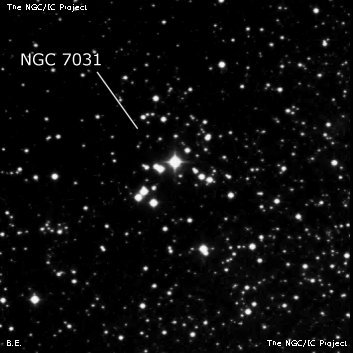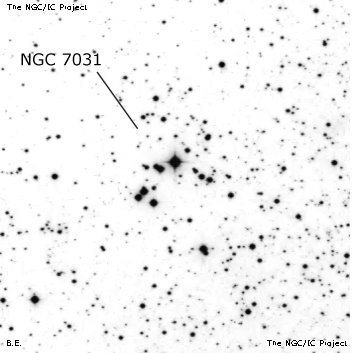NGC/IC Project Restoration Effort
(This is a very very beta version)
NGC7031


Basic Information
Location and Magnitude
Right Ascension: 21:6:52.0
Declination: +50:50:36
Constellation: CYG
Visual Magnitude: 9.1
Historic Information
Discoverer: Herschel W.
Year of discovery: 1788
Discovery aperture: 18.7
Observational
Summary description: Cl of triple st, lC
Sub-type: IV1p
Corwin's Notes
=====
NGC 7031. This is probably a small cluster of fairly bright stars. It was
first seen by WH in September 1788 who called it "A cluster of coarsely
scattered large stars, not rich, 6' diameter." JH followed on about 40 years
later, saying only "A curious scattered cluster of triple stars; RA taken from
working list." This second note is curious in itself as the "working list" RA
is 45 seconds of time on east of WH's reduced position. But the cluster is so
clear from JH comment about triple stars that there can be no mistaking it.
It may actually be larger than WH's (and my) estimate of about 6 arcminutes,
extending west for about 10 or 12 arcminutes from the group of triples. There
appears to be a faint haze of nebulosity over this extended cluster, but the
eastern edge is clearly defined by patches of dark nebulosity. This entire
extended "cluster" may simply be a rich patch of stars seen through a clear
spot in the clouds, so I'm reluctant to say that it really is a cluster. For
the record, this 14' x 11' patch is centered at 21 06 39, +50 52.4 (J2000).
In any event, this extended star cloud is not the cluster that the Herschels
found. The position I've adopted applies to the "cluster of triple stars"
that JH noted.
Steve's Notes
=====
NGC 7031
17.5" (8/10/91): at 220x, about two dozen stars mag 11-15 in a 6' diameter. At the east edge is close double star 11.4/11.8 with a third mag 11.5 star close SW. A nice string of stars is along the north side extending NW from the trio including a close double star 12/13 1' N. A mag 11 star is on south side but the rest of the stars are mag 13-15. Not very rich but stands out in a rich field. The cluster is fairly scattered except for this region with brighter stars. At 410x, I used the sequence of magnitudes in Clark's Visual Astronomy to positively identify a faint V = 16.1 star and suspected a V = 16.3 star.



